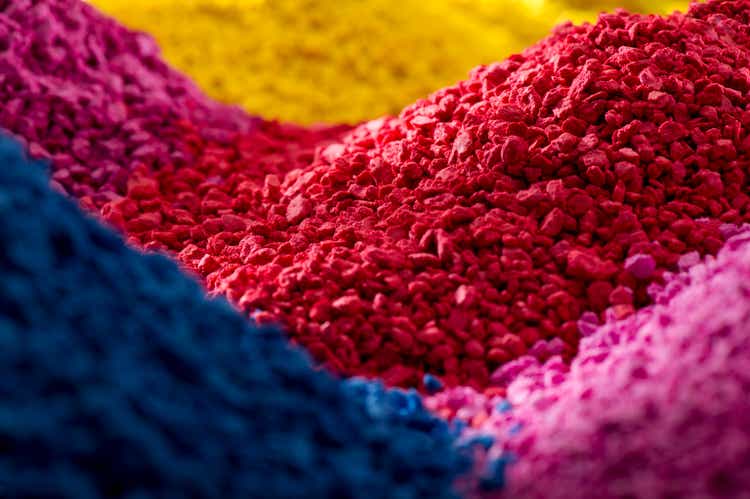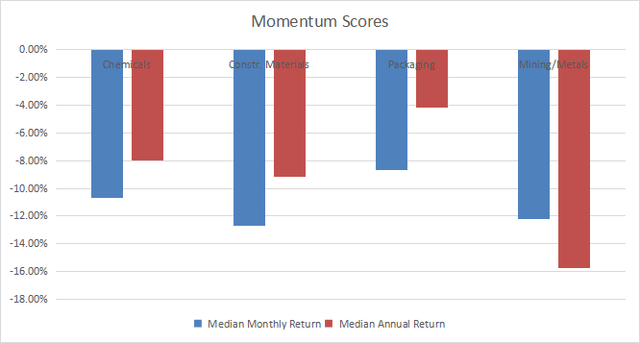VAW: Materials Dashboard For March
Summary
- All subsectors are above their baselines in valuation and quality scores.
- Construction materials and mining/metals are the most attractive ones.
- Fast facts on Vanguard Materials ETF, an alternative to XLB.
- 3 stocks cheaper than their peers in March.
- Quantitative Risk & Value members get exclusive access to our real-world portfolio. See all our investments here »
sturti
This monthly article series shows a dashboard with aggregate industry metrics in materials. It is also a review of sector exchange-traded funds, or ETFs, like the Materials Select Sector SPDR ETF (XLB) and the Vanguard Materials ETF (NYSEARCA:VAW), whose largest holdings are used to calculate these metrics.
Shortcut
The next two paragraphs in italics describe the dashboard methodology. They are necessary for new readers to understand the metrics. If you are used to this series or if you are short of time, you can skip them and go to the charts.
Base Metrics
I calculate the median value of five fundamental ratios for each industry: Earnings Yield ("EY"), Sales Yield ("SY"), Free Cash Flow Yield ("FY"), Return on Equity ("ROE"), Gross Margin ("GM"). The reference universe includes large companies in the U.S. stock market. The five base metrics are calculated on trailing 12 months. For all of them, higher is better. EY, SY and FY are medians of the inverse of Price/Earnings, Price/Sales, and Price/Free Cash Flow. They are better for statistical studies than price-to-something ratios, which are unusable or non-available when the "something" is close to zero or negative (for example, companies with negative earnings). I also look at two momentum metrics for each group: the median monthly return (RetM) and the median annual return (RetY).
I prefer medians to averages because a median splits a set in a good half and a bad half. A capital-weighted average is skewed by extreme values and the largest companies. My metrics are designed for stock-picking rather than index investing.
Value and Quality Scores
I calculate historical baselines for all metrics. They are noted respectively EYh, SYh, FYh, ROEh, GMh, and they are calculated as the averages on a look-back period of 11 years. For example, the value of EYh for packaging in the table below is the 11-year average of the median Earnings Yield in packaging companies.
The Value Score ("VS") is defined as the average difference in % between the three valuation ratios (EY, SY, FY) and their baselines (EYh, SYh, FYh). The same way, the Quality Score ("QS") is the average difference between the two quality ratios (ROE, GM) and their baselines (ROEh, GMh).
The scores are in percentage points. VS may be interpreted as the percentage of undervaluation or overvaluation relative to the baseline (positive is good, negative is bad). This interpretation must be taken with caution: the baseline is an arbitrary reference, not a supposed fair value. The formula assumes that the three valuation metrics are of equal importance.
Current Data
The next table shows the metrics and scores as of last week's closing. Columns stand for all the data named and defined above.
VS | QS | EY | SY | FY | ROE | GM | EYh | SYh | FYh | ROEh | GMh | RetM | RetY | |
Chemicals | 5.17 | 2.29 | 0.0630 | 0.5403 | 0.0109 | 19.85 | 40.16 | 0.0435 | 0.4530 | 0.0212 | 18.00 | 42.57 | -10.67% | -7.96% |
Constr. Materials | 51.08 | 45.60 | 0.0732 | 1.0049 | 0.0429 | 21.64 | 29.93 | 0.0345 | 0.8718 | 0.0341 | 11.50 | 29.02 | -12.71% | -9.13% |
Packaging | 19.49 | 15.75 | 0.0732 | 1.2036 | 0.0347 | 23.41 | 24.82 | 0.0486 | 1.0574 | 0.0369 | 17.70 | 25.02 | -8.68% | -4.19% |
Mining/Metals | 35.46 | 35.49 | 0.0626 | 1.3102 | 0.0353 | 14.81 | 23.58 | 0.0431 | 1.1879 | 0.0234 | 9.37 | 20.88 | -12.18% | -15.76% |
Value and Quality Chart
The next chart plots the Value and Quality Scores by industry (higher is better).
Value and quality in materials (Chart: author; data: Portfolio123)
Evolution Since Last Month
The value score has improved in chemicals, whereas both scores have deteriorated in mining/metal.
Score variations (Chart: author; data: Portfolio123)
Momentum
The next chart plots momentum data.
Momentum in Materials (Chart: author; data: Portfolio123)
Interpretation
All subsectors are above their baselines in valuation and quality scores. The best-looking one is construction materials, followed by mining/metals. Packaging comes in third position. The chemical industry is last but not bad: it is close above its baseline regarding both scores.
Fast Facts on VAW
The Vanguard Materials ETF (VAW) has been tracking the MSCI US IMI Materials 25/50 Index since 01/26/2004. It has a total expense ratio of 0.10%, the same as XLB. It is also available as a mutual fund (VMIAX).
The fund has 114 holdings, but it is quite concentrated. The top 10 companies, listed in the next table, represent 49% of asset value. The top name, Linde Plc, weighs over 14%. Risks related to other companies are moderate.
Ticker | Name | Weight | EPS Growth %TTM | P/E TTM | P/E fwd | Yield% |
Linde Plc | 14.33% | 12.32 | 40.17 | 24.82 | 1.54 | |
Air Products and Chemicals, Inc. | 5.28% | 6.51 | 27.34 | 24.38 | 2.53 | |
Freeport-McMoRan Inc. | 4.88% | -18.18 | 14.98 | 18.68 | 1.06 | |
The Sherwin-Williams Co. | 4.54% | 10.60 | 28.04 | 25.32 | 1.12 | |
Corteva, Inc. | 3.71% | -33.65 | 36.27 | 19.83 | 1.06 | |
Nucor Corp. | 3.58% | 22.86 | 5.04 | 10.71 | 1.41 | |
Ecolab Inc. | 3.40% | -2.52 | 41.79 | 32.19 | 1.33 | |
Dow Inc. | 3.35% | -25.48 | 8.08 | 15.28 | 5.55 | |
DuPont de Nemours, Inc. | 3.02% | 9.02 | 5.69 | 18.02 | 2.12 | |
Newmont Corp. | 2.88% | -137.27 | N/A | 21.03 | 3.47 |
Ratios from Portfolio123
VAW has outperformed XLB in total return since inception (see next table). However, the difference in annualized return is insignificant: only 45 bps. It also shows a marginally higher risk measured in drawdown and standard deviation of monthly returns (volatility).
Total Return | Annualized Return | Max Drawdown | Sharpe Ratio | Volatility | |
VAW | 394.66% | 8.72% | -62.17% | 0.45 | 21.01% |
XLB | 356.84% | 8.27% | -59.83% | 0.44 | 20.24% |
Data calculated with Portfolio123
VAW is a good ETF for investors seeking capital-weighted exposure in basic materials. Its portfolio holds 114 stocks from large to small caps, whereas XLB invests in 32 large companies. VAW is less concentrated in the top holdings: for example, LIN weighs 14.33% vs. 18.53% in XLB. Though, the difference in annualized return since inception is insignificant. XLB has much higher trading volumes, which makes it a better instrument for trading and tactical allocation. Investors who are wary of risks related to the top holding may prefer the Invesco S&P 500® Equal Weight Materials ETF (RTM).
Dashboard List
I use the first table to calculate value and quality scores. It may also be used in a stock-picking process to check how companies stand among their peers. For example, the EY column tells us that a chemical company with an Earnings Yield above 0.0630 (or price/earnings below 15.87) is in the better half of the industry regarding this metric. A Dashboard List is sent every month to Quantitative Risk & Value subscribers, with the most profitable companies standing in the better half among their peers regarding the three valuation metrics at the same time. The list below was sent to subscribers several weeks ago based on data available at this time.
Olin Corp. | |
Veritiv Corp. | |
The Chemours Co. |
It is a dynamic, monthly list with a statistical bias toward excess returns in the long term, not the result of an analysis of each stock.
Quantitative Risk & Value (QRV) features data-driven strategies in stocks and closed-end funds outperforming their benchmarks since inception. Get started with a two-week free trial now.
This article was written by
Step up your investing experience: try Quantitative Risk & Value for free now (limited offer).
I am an individual investor and an IT professional, not a finance professional. My writings are data analysis and opinions, not investment advice. They may contain inaccurate information, despite all the effort I put in them. Readers are responsible for all consequences of using information included in my work, and are encouraged to do their own research from various sources.
Disclosure: I/we have no stock, option or similar derivative position in any of the companies mentioned, and no plans to initiate any such positions within the next 72 hours. I wrote this article myself, and it expresses my own opinions. I am not receiving compensation for it (other than from Seeking Alpha). I have no business relationship with any company whose stock is mentioned in this article.


